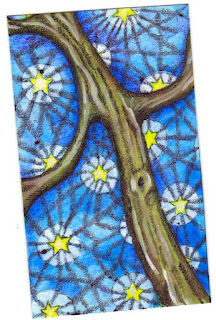 |
| Savannah Schroll Guz, "Herringbone Shine" (2012) watercolor, colored pencil, ink on Strathmore 400 Series paper |
It's strange, the series that are born from idle doodles. Well, I suppose the first 'doodle' wasn't necessarily idle. I was starting to experiment with watercolor because I knew that I couldn't work forever in only black ink on white paper. My shop had begun to look monochromatic and bland *yawn*. I also began experimenting because I wanted to stretch beyond what I was comfortable with, beyond what I knew. So, with my fingers hanging from my beltloops in an aisle of Hobby Lobby, I decided on a set of Niji watercolors. After some false starts, I've begun this series, which I've talked about here before. However, "Herringbone Shine" was just completed today.
 |
| Savannah Schroll Guz, "Sea Stars" (2012), watercolor and ink on Strathmore 400 Series paper |
Watercolor itself is so, so different than acrylic. There is little room for error. Obviously, you can't simply paint over a portion you don't like without losing the gorgeous translucence that makes watercolors so visually appealing. Watercolor is almost like a thin scrim of fabric pulled over a light box. It glows from within. And I like these brilliant jewel tones. I remember having tried watercolor in college and having had a subtle dislike for it because I couldn't 'work' the colors. It had no bulk to build up or move around easily. I like to make the images I create with acrylic bend and shift. But watercolor...watercolor stains the paper and dries. Period. Plus if I did apply wet color on top of dry color, as I often do with acrylic, everything would go all muddy on me. A subtle veil of glaze (glaze = watered down pigment washed over an existing image painted on canvas), which usually covers a multitude of canvas-bound sins, simply doesn't work in watercolor. And, perhaps most disquieting, is that watercolor wrests control from the painter...you may not have intended for the pigment to explode into the surrounding moisture like a broken capillery, but it often does. And, as with ink, you have to work with that new pattern of pigmentation. So, not only can you not fix mistakes, you, as a watercolorist, must incorporate the accidental seeping of color or the mistaken brushstroke. All of this makes the artist--at least this artist--feel very vulnerable. But I'm starting to get the hang of things...I've got so much more to learn.
Thanks for the informative post..I'll be experimenting with watercolors soon on my sketches..Looking forward to seeing more works in watercolor!
ReplyDeleteThank you, Wendy, so much! :-) One other thing I realized, too, is the paper is really important. Usually when I draw, I use cardstock, but I've found that cardstock doesn't work very well with watercolor. Even though the watercolor paper has texture (which sometimes makes drawing and shading a bit challenging...at least for me), the watercolor paper accepts the color so much more easily and beautifully than the cardstock does, which just seems to begin showing its paper pulp when it gets damp.
ReplyDeleteI'll definitely be checking back with your blog to see your upcoming works!